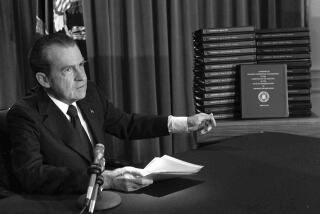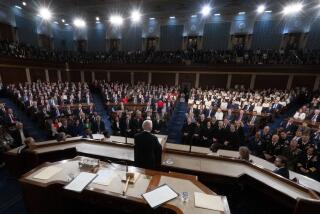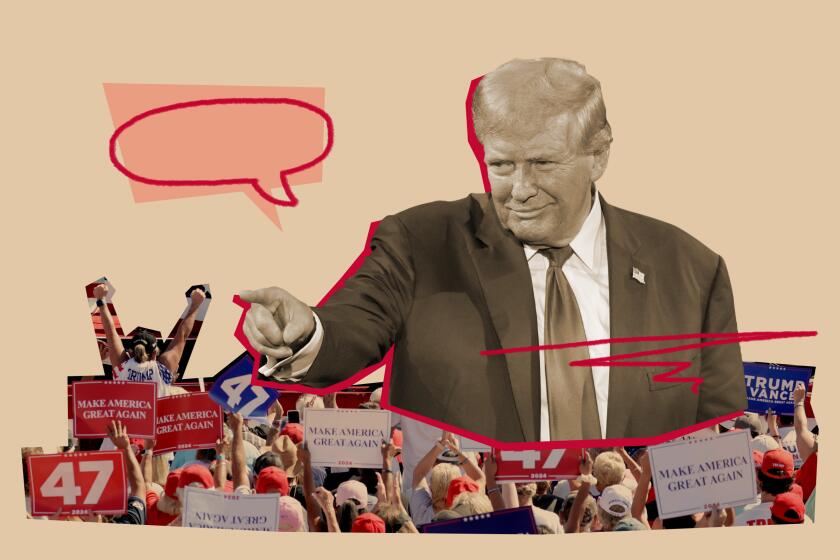Perot’s Bitter Medicine for Debt an Old Recipe
Is Ross Perot another Alexander Hamilton? That’s a question to be asking this week.
Hamilton, the first secretary of the Treasury, took a bankrupt infant nation, and by credibly pledging the federal government to pay the debts of all the states, he set the United States on a course that gave it a rock-solid credit rating and a prosperous future.
Perot, the billionaire entrepreneur, has focused his otherwise erratic political campaign on cutting the $330-billion federal deficit and reducing the $4-trillion national debt. He has published a program of tax increases, spending cuts and investment incentives that he calculates would eliminate the deficit by 1998.
The conventional wisdom calls Perot’s program economically caustic and politically unwise. A top adviser to Democratic candidate Bill Clinton says the fragile economy might break under the discipline of Perot’s reforms; a leading Republican says no way would President Bush back Perot’s plan to raise gasoline taxes by 50 cents a gallon over five years.
To be sure, the program contains harsh medicine. Perot would raise to 33% the marginal tax rate on individuals earning $55,500 a year, and couples earning $89,250. He would hike premiums on Medicare, taxes on Social Security benefits for many recipients and taxes on company-paid medical insurance premiums for employees.
But just because medicine tastes bad, doesn’t mean we should avoid it. The main virtue of Perot’s program, which was drawn up by a team of economists, is that it lets us know some of the things that need to be done--even if Ross Perot himself is not a serious candidate for President.
As outlined in the book “United We Stand,” Perot’s program speaks openly of U.S. fiscal problems, while Bush and Clinton only mumble and evade.
Perot’s gasoline tax, for example--adding 10 cents a gallon per year for five years--would be used to rebuild highways, construct transportation networks and build “a telecommunications system for the 21st Century.”
Clinton also wants to use public funds for advanced communications, but is less than specific on financing. Bush would lower taxes and assume money would flow to advancing technology. Both advocate debt repayment without tears and balanced budgets without pain.
“Perot’s is an honest program,” says economist Barry Bosworth of the Brookings Institution. “It could establish credibility in the markets and bring down long-term interest rates.”
“Global bond buyers would be enthused; the Treasury 10-year bond would decline to 5.5%” says economist Roger Brenner of the consulting firm DRI McGraw Hill, who worked on the Perot program.
In other words, the sometime candidate may be eccentric, but his economic program has merit.
And politically, Perot may be tapping a deep and historic instinct in the American people, who have borrowed money and paid it back before.
When Hamilton took hold of the economy in 1789, the public debt stood at $77 million--an enormous amount for the time. He pledged to pay it all, including accrued interest, and devised a repayment schedule that would reduce the debt over a long period.
It wasn’t easy--debt service in the 1790s often amounted to 80% of government revenue--but Hamilton stuck to it and established credibility in world markets. And by 1803 it was possible for the young country to finance the Louisiana Purchase.
The Civil War drove up the national debt, and it was paid down in the remaining decades of the 19th Century even as the country industrialized and spread westward. Similarly, borrowing rose for World Wars I and II, and was repaid gradually in decades that followed.
Now the Cold War’s end finds the national debt higher than ever--approaching $16,000 for every American--amid growing fears of how hard it will be to repay.
Common sense says the deficit cannot be eliminated quickly. “Hamilton reduced the debt over a long period,” notes Jude Wanniski, head of Polyconomics, an economic consulting firm. “He allowed economic growth to make the debt more manageable.”
All of today’s candidates, declared and undeclared, see economic growth as essential in 1993. If reelected, Bush will push for tax cuts early in the year. Clinton would push for public works programs.
Perot’s program wouldn’t begin deficit reduction until 1994, just in case the economy needs short-term stimulus in 1993.
The timing of budget cuts is less important than the credibility of ultimate goals because world markets may not let the next President play politics with the deficit. The U.S. dollar is hitting new lows these days as investors--domestic and foreign, institutional and individual--size up the economic programs of the two major candidates. They are looking for sterner stuff.
Satisfying global investors is not new--we have always had creditors. And today, as in 1789, they need to see credible programs and purposeful action.
That’s why, amid all of this week’s publicity, the Perot economic program should get more attention than the reluctant candidate himself.
REPAYING OUR WAY
The national debt has risen to pay for wars or hard times through all of U.S. history, but it has always been paid down when peace or prosperity returned. Until now. The chart of outstanding debt per each American since before the Civil War, shows that we are at a high--and still rising--point for indebtedness.
National debt per capita in 1991 dollars 1860 $33.79 1991 $14,244.10Sources: Jack W. Wilson, North Carolina State University; Richard Sylla, New York University.
More to Read
Get the L.A. Times Politics newsletter
Deeply reported insights into legislation, politics and policy from Sacramento, Washington and beyond. In your inbox three times per week.
You may occasionally receive promotional content from the Los Angeles Times.










